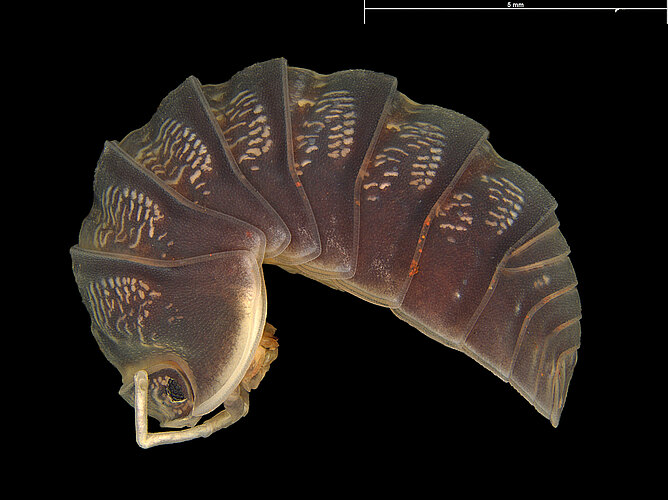Specialised Pilbara Slater
Buddelundia
FP-12447 (SJ 50)
Discoverer: S. Judd (2023)
Fauna Portal species: 12447Diagnosis
Large animal. Frontal shield divided into upper and lower sections by a transverse groove. Upper part of frontal shield distinct along entire length and raised slightly from the vertex of the head (Fig. 6888). Pereonite 1 with epimera border angled slightly backward and often with pale distal margin. Epimera of first pereonite highly developed, thickened at distal edge and extending horizontally. Interlocking structure on pereonite 7 (Fi. 6893). This is a highly derived Buddelundia and is diagnosed principally by the interlocking structures on the first two pereonites (Figs 6891, 6892).
There are numerous Buddelundia of this type found only in the Pilbara region and probably more to be discovered. All are specialised and have limited distributions. Diagnosis of these species should be confirmed by molecular methods (COI barcoding).
Status
- native
Fauna Portal Reference
Australia
- Western Australia
Fauna Portal Records
The map shows all records that have been verified as part of the Fauna Portal project and may not represent the true distribution of a species. Specifically, for described species, check the link to the Atlas of Living Australia on this page for potential wider distributions. Fauna Portal Reference specimens and Linnean types are shown in red. If you identified a specimen that exceeds the distribution of an undescribed species as illustrated here, please contact the Fauna Portal team who can assist with the lodgement of the specimen in a public institution and display on the map.
Isopoda (slaters)
- Alloniscidae
- Armadillidae
- Acanthodillo
- Armadillidae gen. indet.
- Armadillidae genus 3506 ('Reduropoda')
- Armadillidae genus 466 (BWI gen. 1)
- Barrowdillo
- Buddelundia
- callosa
- cinerascens
- FP-11773 (SJ 10MA)
- FP-11777 (SJ 14FM-c)
- FP-11778 (SJ 14FM-a)
- FP-11779 (SJ 13MD)
- FP-11783 (SJ 14RE)
- FP-11784 (SJ 32UAa)
- FP-11785 (SJ 32UAb)
- FP-11786 (SJ 34UA)
- FP-11792 (SJ 10BF)
- FP-11793 (SJ 13PE)
- FP-11796 (SJ 15MD)
- FP-11798 (SJ 14fm)
- FP-11799 (SJ 16)
- FP-11800 (SJ 49fm)
- FP-11809 (SJ 14HR)
- FP-11810 (SJ 36)
- FP-11811 (SJ 63)
- FP-11812 (SJ 64)
- FP-11813 (SJ wyloo)
- FP-11814 (SJ 36/66)
- FP-11816 (SJ 13WO)
- FP-11819 (SJ J6)
- FP-11856
- FP-12447 (SJ 50)
- FP-12448 (SJ 56)
- FP-12636 (SJ 13)
- FP-13123
- FP-13124
- FP-13125
- FP-13132
- FP-13134
- FP-13136
- FP-13169
- FP-13170
- FP-13300
- FP-13355
- FP-13356
- FP-13357
- FP-13360
- FP-13361
- FP-13363
- FP-13377 (SJ 15)
- FP-13529
- FP-13530
- FP-13531
- FP-13532
- FP-13533
- FP-13534
- FP-13535
- FP-13713
- FP-13715
- FP-13971
- FP-14081
- FP-14082
- FP-14083
- FP-14084
- FP-14085
- FP-14086
- FP-14103
- FP-14413
- FP-2668 (BWI sp. 1)
- FP-2669 (BWI sp. 2)
- FP-2670 (BWI sp. 3)
- FP-2671 (BWI sp. 4)
- FP-2672 (BWI sp. 5)
- frontosa
- hirsuta
- labiata
- nigripes
- sulcata
- Buddelundiinae gen. indet.
- Cubaris
- Pseudodiploexochus
- Spherillo
- Troglarmadillo
- Acanthodillo
- Ligiidae
- Olibrinidae
- Philosciidae
- Porcellionidae
All classes
- Arachnida
- Crustacea
- Entognatha
- Gastropoda
- Insecta
- Orthoptera - Caelifera (Grasshoppers)
- Hymenoptera excl. Formicidae (bees and wasps)
- Blattodea s. str. (Cockroaches)
- Coleoptera (Beetles)
- Dermaptera (earwigs)
- Diptera (flies, mosquitos)
- Entomobryomorpha (slender springtails)
- Hemiptera - Heteroptera (True Bugs)
- Hemiptera - Sternorrhyncha (aphids, scales etc.)
- Hemiptera - Auchenorrhyncha (cicadas, planthoppers)
- Hymenoptera - Formicidae (Ants)
- Trichoptera (Caddisflies)
- Zygentoma (silverfish)
- Myriapoda

